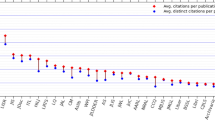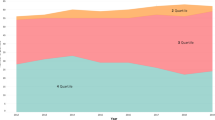Abstracts
Despite its problems, journal impact factor (JIF) is the most popular journal quality metric. In this paper, two simple adjustments of JIF are tested to see whether more equality among fields can be attained. In author-weighted impact factor (AWIF), the number of citations that a journal receive is divided by the number of authors in that journal. In reference return ratio (RRR), the number of citations that a journal receive is divided by the number of references in that journal. We compute JIF, AWIF and RRR of all 10,848 journals included in journal citation report 2012. Science journals outperform social science journals at JIF but social science journals outperform science journals at both AWIF and RRR. Highest level of equality between science and social science journals is attained when AWIF is used. These findings cannot be generalized when narrower subject categories are considered.







Similar content being viewed by others
Notes
The names of the group authors are also given in this column. For example, there are 1067 articles that have more than 100 authors in 2010 and 2011. Consequently, we are able to include articles with group authors in our calculations.
We also do not take distinct number of articles in the cited-references. For example if the same article is cited in Journal X in three different articles, then that cited-article will be counted three times.
References
Abramo, G., & D’Angelo, C. A. (2015). The relationship between the number of authors of a publication, its citations and the impact factor of the publishing journal: Evidence from Italy. Journal of Informetrics, 9(4), 746–761.
Ahlgren, P., Colliander, C., & Sjogarde, P. (2018). Exploring the relation between referencing practices and citation impact: A large-scale study based on Web of Science data. Journal of the Association for Information Science and Technology, 69(5), 728–743.
Althouse, B. M., West, J. D., Bergstrom, C., & Bergstrom, T. (2009). Differences in impact factor across fields and over time. Journal of the American Society for Information Science and Technology, 60(1), 27–34.
Archambault, E., & Lariviere, V. (2009). History of the journal impact factor: Contingencies and consequences. Scientometrics, 79(3), 635–649.
Castelvecchi, D. (2015) Physics paper sets record with more than 5,000 authors. Nature News (May 15).
Didegah, F., & Thelwall, M. (2013). Which factors help authors produce the highest impact research? Collaboration, journal and document properties. Journal of Informetrics, 7(4), 861–873.
Franceschini, F., Galetto, M., Maisano, D., & Mastrogiacomo, L. (2012). The success-index: An alternative approach to the h-index for evaluating an individual’s research output. Scientometrics, 92(3), 621–641.
Harzing, A., Alakangas, S., & Adams, D. (2014). hIa: An individual annual h-index to accommodate disciplinary and career length differences. Scientometrics, 99(3), 811–821.
Johnston, D. M., Piatti, M., & Torgler, B. (2013). Citation success over time: Theory or empirics? Scientometrics, 95(3), 1023–1029.
King, C. (2012). Multiauthor papers: onward and upward. Sciencewatch newsletter.
Kosmulski, M. (2011). Successful papers: A new idea in evaluation of scientific output. Journal of Informetrics, 5(3), 481–485.
Leydesdorff, L., & Bornmann, L. (2011). How fractional counting of citations affects the impact factor: Normalization in terms of differences in citation potentials among fields of science. Journal of the American Society for Informatıon Science and Technology, 62(2), 217–229.
Leydesdorff, L., & Opthof, T. (2010). Scopus’s source normalized impact per paper (SNIP) versus a journal impact factor based on fractional counting of citations. Journal of the Amerıcan Society for Information Science and Technology, 61(11), 2365–2369.
Leydesdorff, L., & Opthof, T. (2011). Remaining problems with the “New Crown Indicator” (MNCS) of the CWTS. Journal of Informetrics, 5(1), 224–225.
Lundberg, J. (2007). Lifting the crown—Citation z-score. Journal of Informetrics, 1(2), 145–154.
Marx, W., & Bornmann, L. (2015). On the causes of subject-specific citation rates in Web of Science. Scientometrics, 102(2), 1823–1827.
Moed, H. F. (2010). Measuring contextual citation impact of scientific journals. Journal of Informetrics, 4(3), 265–277.
Nicolaisen, J., & Frandsen, T. F. (2008). The reference return ratio. Journal of Informetrics, 2(2), 128–135.
Podlubny, I. (2005). Comparison of scientific impact expressed by the number of citations in different fields of science. Scientometrics, 64(1), 95–99.
Radicchi, F., & Castellano, C. (2012). Testing the fairness of citation indicators for comparison across scientific domains: The case of fractional citation counts. Journal of Informetrics, 6(1), 121–130.
Ramirez, A. M., Garcia, A. O., & Del Rio, J. A. (2000). Renormalized impact factor. Scientometrics, 47(1), 3–9.
Rossner, M., Van Epps, H., & Hill, E. (2007). Show me the data. The Journal of Cell Biology, 179(6), 1091–1092.
Ruiz-Castillo, J., & Waltman, L. (2015). Field-normalized citation impact indicators using algorithmically constructed classification systems of science. Journal of Informetrics, 9(1), 102–117.
Sombatsompop, N., & Markpin, T. (2005). Making an equality of ISI impact factors for different subject fields. Journal of the American Society for Information Science and Technology, 56(7), 676–683.
Vinkler, P. (2009). Introducing the Current Contribution Index for characterizing the recent, relevant impact of journals. Scientometrics, 79(2), 409–420.
Waltman, L. (2016). A review of the literature on citation impact indicators. Journal of Informetrics, 10(2), 365–391.
Waltman, L., & van Eck, N. J. (2013). Source normalized indicators of citation impact: An overview of different approaches and an empirical comparison. Scientometrics, 96(3), 699–716.
Waltman, L., van Eck, N. J., van Leeuwen, T. N., Visser, M. S., & van Raan, A. F. J. (2011). Towards a new crown indicator: Some theoretical considerations. Journal of Informetrics, 5(1), 37–47.
Woolston, C. (2015) Fruit-fly paper has 1,000 authors. Nature News (May 13).
Wutchy, S., Jones, B. F., & Uzzi, B. (2007). The increasing dominance of teams in production of knowledge. Science, 316, 1036–1038.
Yanovski, V. I. (1981). Citation analysis significance of scientific journals. Scientometrics, 3(3), 223–233.
Yuret, T. (2014). Why do economists publish less? Applied Economics Letters, 21(11), 760–762.
Yuret, T. (2015). Interfield comparison of academic output by using department level data. Scientometrics, 105(3), 1653–1664.
Zhang, Z., Cheng, Y., & Liu, N. C. (2014). Comparison of the effect of mean-based method and z-score for field normalization of citations at the level of Web of Science subject categories. Scientometrics, 101(3), 1679–1693.
Zitt, M., Ramanana-Rahary, S., & Bassecoulard, E. (2005). Relativity of citation performance and excellence measures: From cross-field to cross-scale effects of field-normalisation. Scientometrics, 63(2), 373–401.
Zitt, M., & Small, H. (2008). Modifying the journal impact factor by fractional citation weighting: The audience factor. Journal of the American Society for Information Science and Technology, 59(11), 1856–1860.
Author information
Authors and Affiliations
Corresponding author
Rights and permissions
About this article
Cite this article
Yuret, T. Author-weighted impact factor and reference return ratio: can we attain more equality among fields?. Scientometrics 116, 2097–2111 (2018). https://doi.org/10.1007/s11192-018-2806-7
Received:
Published:
Issue Date:
DOI: https://doi.org/10.1007/s11192-018-2806-7




